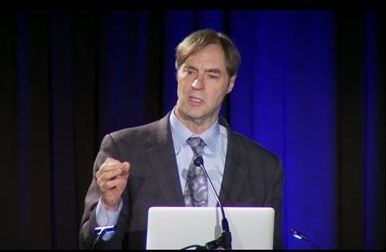|
home | what's new | other sites | contact | about |
|||
|
Word Gems exploring self-realization, sacred personhood, and full humanity
Dr. Stephen C. Meyer
return to "Evolution" main-page
from https://stephencmeyer.org/2001/05/16/the-meanings-of-evolution/
Principal Meanings of Evolution in Biology Textbooks5. Universal common descent: the idea that all organisms have descended from a single common ancestor Evolution as Universal Common Descent. Many biologists commonly use the term evolution to refer to the idea that all organisms are related by common ancestry from a single living organism. Darwin represented the theory of universal common descent or universal “descent with modification” with a “branching tree” diagram, which showed all present life forms as having emerged gradually over time from one or very few original common ancestors. Darwin’s theory of biological history is often referred to as a monophyletic view because it portrays all organisms as ultimately related as a single family. In the Origin of Species, Charles Darwin argued for his theory of universal common descent on the grounds that it best explained a variety of biological evidences, including fossil succession, biogeographical distribution of species (such as the Galapagos finches), the existence of apparently suboptimal or useless organs, and the existence of homologous structures and embryological similarities in otherwise disparate organisms. The presumed strength of the case for universal common descent has led many scientists to treat the theory of universal common descent as though it were a fact. Maynard M. Metcalf and more recently Stephen Jay Gould and Michael Ruse have been among prominent advocates of the idea that evolution defined as “universal common ancestry” qualifies as a fact. Each of these advocates articulated this view while serving as an expert witness in a creation-evolution court trial. Yet as one of us (Meyer) has argued in response to Michael Ruse, universal common descent is not, strictly speaking, a fact. As Meyer noted: Strictly speaking, common descent is an abductive or historical inference, as Professor Ruse himself acknowledges when he speaks more accurately of “inferring historical phylogenies.” As defined by C. S. Peirce, abductive inferences attempt to establish past causes by viewing present effects. (As such, it is more accurate to refer to common descent as a theory about facts, i.e., a theory about what in fact happened in the past.) Unfortunately, such theories, and the inferences used to construct them, can be notoriously underdetermined. As Elliot Sober points out, many possible pasts often correspond to any given present state. Establishing the past with certainty, or even beyond reasonable doubt, can therefore, be very difficult. Although Darwin’s monophyletic view of life’s history has reigned as the dominant theory of the history of life during most of the twentieth century, a number of biologists now question that view on evidential grounds. These scientists now see the present diversity and disparity of organisms as having originated from many separate ancestral forms and lines of descent. Those favoring a so-called polyphyletic or multiple separate origins view of life’s history now cite evidence from paleontology, embryology, biochemistry, and molecular biology in support of their view. Evolution in the fifth sense not only specifies that all life shares a common ancestry, it implies that virtually no limits exist to the amount of morphological change that can occur in organisms. It assumes that relatively simple organisms can, given adequate time, change into much more complex or different organisms, and these organisms can in turn be altered by the evolutionary process to become yet new organisms. Thus, evolution in this sense entails the idea of unbounded biological change. That view is now opposed by biologists who see biological change as limited and who favor a polyphyletic view of life’s history, in which many lineages of animals or plants arise separately (without genealogical connections) during the history of life. Because Darwin’s monophyletic interpretation of life’s history is an inference from biological evidence, instructors should encourage students to understand and examine classical Darwinian arguments for that interpretation rather than simply presenting the interpretation as brute fact. Moreover, since several lines of evidence and many qualified scientists now challenge this theory of the history of life, the evidence for alternate polyphyletic theories of life’s history should also be discussed and critically evaluated. Allowing students to see how scientists interpret the same biological evidence differently will help encourage evaluation and critical thinking skills. It will also allow students to understand the method of multiple competing hypotheses that scientists often employ to evaluate their data. We will return to this fifth meaning of evolution in the last sections of this essay when we critique public statements about how evolutionary theory should be taught in public schools. At present, many public policy (and other) statements about how to teach evolution lapse uncritically into describing evolution (that is, universal common descent) as a fact. In addition to the five definitions of evolution discussed thus far, an additional definition lies at the core of what evolutionary biology means to most scientists today.
|
